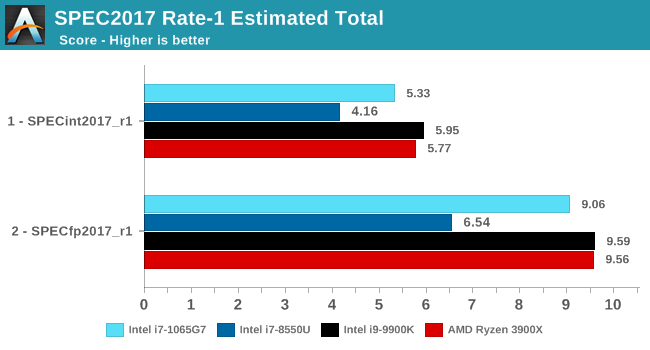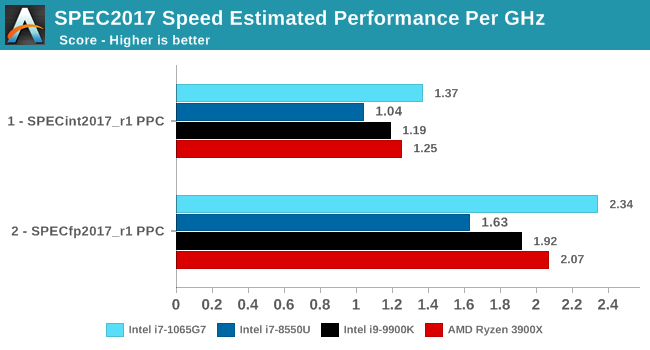The Ice Lake Benchmark Preview: Inside Intel's 10nm
by Dr. Ian Cutress on August 1, 2019 9:00 AM EST- Posted in
- CPUs
- Intel
- GPUs
- 10nm
- Core
- Ice Lake
- Cannon Lake
- Sunny Cove
- 10th Gen Core
Section by Andrei Frumusanu
SPEC2017 and SPEC2006 Results (15W)
SPEC2017 and SPEC2006 is a series of standardized tests used to probe the overall performance between different systems, different architectures, different microarchitectures, and setups. The code has to be compiled, and then the results can be submitted to an online database for comparsion. It covers a range of integer and floating point workloads, and can be very optimized for each CPU, so it is important to check how the benchmarks are being compiled and run.
We run the tests in a harness built through Windows Subsystem for Linux, developed by our own Andrei Frumusanu. WSL has some odd quirks, with one test not running due to a WSL fixed stack size, but for like-for-like testing is good enough. SPEC2006 is deprecated in favor of 2017, but remains an interesting comparison point in our data. Because our scores aren’t official submissions, as per SPEC guidelines we have to declare them as internal estimates from our part.
For compilers, we use LLVM both for C/C++ and Fortan tests, and for Fortran we’re using the Flang compiler. The rationale of using LLVM over GCC is better cross-platform comparisons to platforms that have only have LLVM support and future articles where we’ll investigate this aspect more. We’re not considering closed-sourced compilers such as MSVC or ICC.
clang version 8.0.0-svn350067-1~exp1+0~20181226174230.701~1.gbp6019f2 (trunk)
clang version 7.0.1 (ssh://git@github.com/flang-compiler/flang-driver.git
24bd54da5c41af04838bbe7b68f830840d47fc03)-Ofast -fomit-frame-pointer
-march=x86-64
-mtune=core-avx2
-mfma -mavx -mavx2
Our compiler flags are straightforward, with basic –Ofast and relevant ISA switches to allow for AVX2 instructions. Despite ICL supporting AVX-512, we have not currently implemented it, as it requires a much greater level of finesse with instruction packing. The best AVX-512 software uses hand-crafted intrinsics to provide the instructions, as per our 3PDM AVX-512 test later in the review.
For these comparisons, we will be picking out CPUs from across our dataset to provide context. Some of these might be higher power processors, it should be noted.
SPECint2006

Amongst SPECint2006, the one benchmark that really stands out beyond all the rest is the 473.astar. Here the new Sunny Cove core is showcasing some exceptional IPC gains, nearly doubling the performance over the 8550U even though it’s clocked 100MHz lower. The benchmark is extremely branch misprediction sensitive, and the only conclusion we can get to rationalise this increase is that the new branch predictors on Sunny Cove are doing an outstanding job and represent a massive improvement over Skylake.
456.hmmer and 464.h264ref are very execution bound and have the highest actual instructions per clock metrics in this suite. Here it’s very possible that Sunny Cove’s vastly increased out-of-order window is able to extract a lot more ILP out of the program and thus gain significant increases in IPC. It’s impressive that the 3.9GHz core here manages to match and outpace the 9900K’s 5GHz Skylake core.
Other benchmarks here which are limited by other µarch characteristics have various increases depending on the workload. Sunny Cove doubled L2 cache should certainly help with workloads like 403.gcc and others. However because we’re also memory latency limited on this platform the increases aren’t quite as large as we’d expect from a desktop variant of ICL.

In SPECfp2006, Sunny Cove’s wider out-of-order window can again be seen in tests such as 453.povray as the core is posting some impressive gains over the 8550U at similar clocks. 470.lbm is also instruction window as well as data store heavy – the core’s doubled store bandwidth here certainly helps it.

Overall in SPEC2006, the new i7-1065G7 beats a similarly clocked i7-8550U by a hefty 29% in the int suite and 34% in the fp suite. Of course this performance gap will be a lot smaller against 9th gen mobile H-parts at higher clocks, but these are also higher TDP products.
The 1065G7 comes quite close to the fastest desktop parts, however it’s likely it’ll need a desktop memory subsystem in order to catch up in total peak absolute performance.

Performance per clock increases on the new Sunny Cove architecture are outstandingly good. IPC increases against the mobile Skylake are 33 and 38% in the integer and fp suites, though we also have to keep in d mind these figures go beyond just the Sunny Cove architecture and also include improvements through the new LPDDR4X memory controllers.
Against a 9900K, although apples and oranges, we’re seeing 13% and 14% IPC increases. These figures likely would be higher on an eventual desktop Sunny Cove part.
SPEC2017



The SPEC2017 results look similar to the 2006 ones. Against the 8550U, we’re seeing grand performance uplifts, just shy of the best desktop processors.

Here the IPC increase also look extremely solid. In the SPECin2017 suite the Ice Lake part achieves a 14% increase over the 9900K, however we also see a very impressive 21% increase in the fp suite.
Overall in the 2017 suite, we’re seeing a 19% increase in IPC over the 9900K, which roughly matches Intel’s advertised metric of 18% IPC increase.










261 Comments
View All Comments
Phynaz - Saturday, August 3, 2019 - link
You guessed wrong, but considering your education level that should be expectedKorguz - Saturday, August 3, 2019 - link
i did ?? sure seems like you only want quad cores still... my guess, yours is maybe grade 10.AntonErtl - Friday, August 2, 2019 - link
I am guessing that SPEC CPU2017 Rate-1 means one copy of the benchmark, so it also gives us single-thread performance (and that explains why the power limit differences do not play a bigger role). Right?One thing that I find remarkable about the recent AMD and Intel launches is that Intel follows the pattern (already seen with Broadwell) of starting a new process with a low clock, and therefore with mobile products and then servers. If they follow their earlier pattern, we will see higher-clocked stuff on 10nm in the future.
By contrast, AMD (and the smartphone SoC vendors) manage to get the same or better clock rates with the newer process as with the older ones.
From what I hear, Intel is very much into hand-tuning their CPUs (that's why backporting Ice Lake to 14nm would be very expensive in terms of both labor and time-to-market), while AMD and the smartphone SoC vendors rely on more automatic tools. What is interesting is that AMD managed to get within a few % of clock rate of a highly tuned Intel chip (with several years of tuning both the process and the layout of the chip) with this more automatic approach, while having a similar IPC.
Intel has been working on Ice Lake and 10nm for a while, and still suffer from a clock rate deficit compared to Whiskey Lake (but in a way, 10nm is just becoming usefully online now, so maybe we should start the clock now). The fact that they have increased the TDP of the Y SKUs and decreased the base clock of the 15W SKUs (from 1.9GHz for the 8665U to 1.3GHz for the 1065G7) indicates that they still have problems being competitive wrt power consumption under load with Whiskey Lake. It will be interesting to see the final products (and compare them to Whiskey Lake and Picasso products with similar power delivery and cooling).
Phynaz - Friday, August 2, 2019 - link
AMD pushes their overvolted chips to the very limit. Intel doesn’t have to.Korguz - Friday, August 2, 2019 - link
" Intel doesn’t have to. " um.. i guess you havent seen the articles about how much intels cpus really use then. 95 watts, up to 200 watts in realityPhynaz - Saturday, August 3, 2019 - link
Wow, you’re really, really dumb. Do you get state aid?Korguz - Saturday, August 3, 2019 - link
oh how so ?? AT even posted a write up on this, obviously, you havent read it. so you are the one that needs aid, as you are the dumb one here....Alexvrb - Monday, August 5, 2019 - link
Reading isn't Phynaz' strong suit. However when you state a fact he can't counter, he immediately switches to low brow personal attacks - those are really more his speed.mobutu - Friday, August 2, 2019 - link
It doesn't mattter (for me), this time I'll buy AMD.HStewart - Friday, August 2, 2019 - link
Then why comment if it doesn't matter to you.